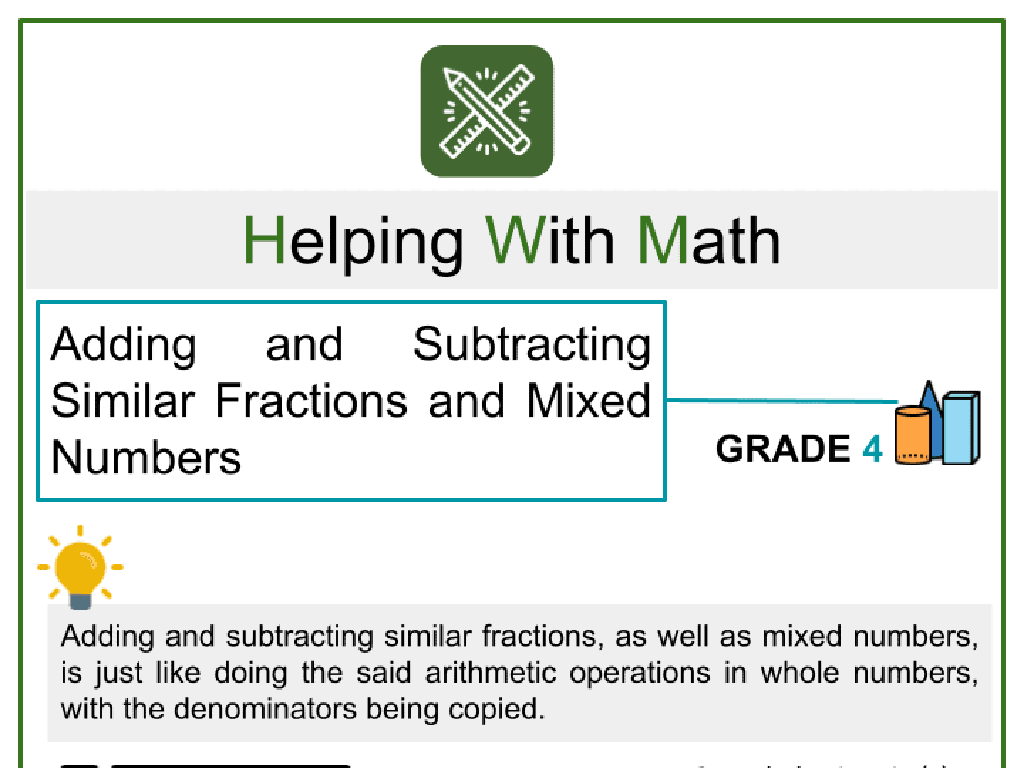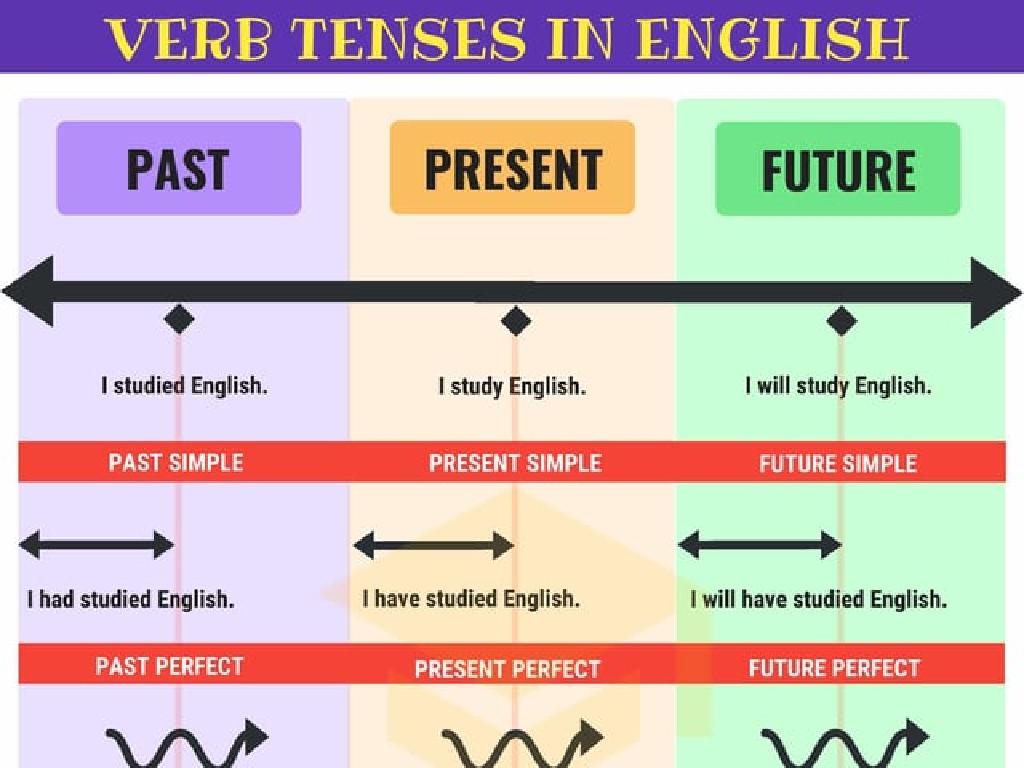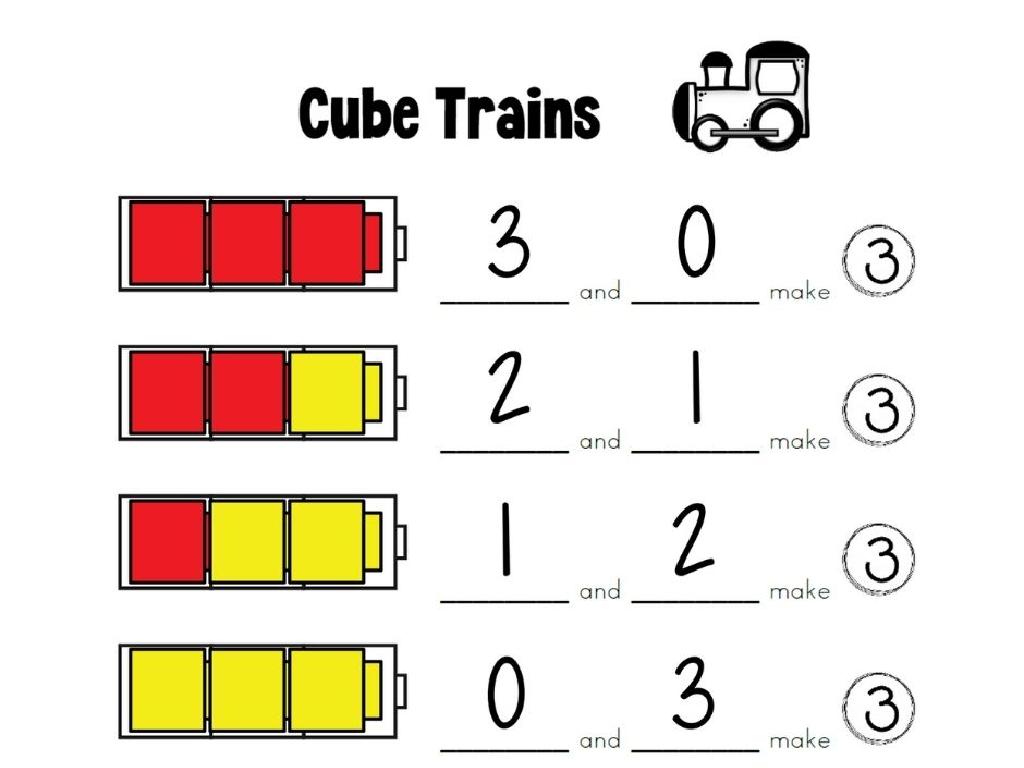Skip-Counting Sequences
Subject: Math
Grade: Second grade
Topic: Skip-Counting And Number Patterns
Please LOG IN to download the presentation. Access is available to registered users only.
View More Content
Welcome to Skip-Counting!
– What is Skip-Counting?
– Counting by numbers other than 1, like 2, 5, or 10
– Benefits of Skip-Counting
– Helps with math like addition, telling time, and counting money
– Skip-Counting in daily life
– Using skip-counting to share candies equally or count stairs by twos
– Practice with examples
– Let’s count by 2s: 2, 4, 6, 8, who do we appreciate?
|
This slide introduces the concept of skip-counting, a fundamental skill in early mathematics education. Skip-counting involves counting forwards or backwards by numbers other than one. It’s a stepping stone to understanding multiplication and division, and it’s useful in practical situations like adding up coins or dividing objects evenly among a group. Provide examples that are relatable to second graders, such as sharing treats or counting objects in pairs. Encourage students to practice skip-counting by 2s, 5s, and 10s with interactive activities and songs to make learning engaging and fun.
Understanding Patterns in Skip-Counting
– Patterns exist everywhere
– Sequences can form patterns
– A pattern repeats according to a rule
– How to spot number patterns
– Look for repetition or a rule in a sequence
– Practice with skip-counting
– Try counting by 2s, 5s, or 10s
|
This slide introduces the concept of patterns in the context of skip-counting. Begin by explaining that patterns are not just in math but all around us in nature, art, and music. Then, discuss what makes a sequence a pattern, emphasizing that there must be a rule that repeats. Show examples of number patterns, such as counting by 2s (2, 4, 6, 8…) and ask students to identify the rule. Finally, engage students in practicing skip-counting by different numbers to help them recognize and form patterns themselves. Encourage students to explain the patterns they see and to create their own sequences following a pattern.
Skip-Counting by 2s
– Counting by 2s
– See the pattern: 2, 4, 6, 8, …
– Each number is 2 more than the last
– Count pairs of items
– Shoes, socks, or gloves come in pairs
– Practice with fun activities
– Use objects like blocks or stickers
|
This slide introduces the concept of skip-counting by 2s, which is a fundamental skill in understanding even numbers and preparing for multiplication. Start by counting aloud with the class, emphasizing the pattern that each number is two more than the one before it. Provide visual examples with pairs of items to help students make real-world connections. For practice, engage students with hands-on activities using objects like blocks or stickers to count in pairs. This will help solidify their understanding of the concept through interactive learning.
Skip-Counting by 5s
– Counting by 5s is a blast!
– Examples: 5, 10, 15, 20, …
– Start at 5 and add 5 more each time
– Use a clock to learn 5s
– Each number on the clock represents 5 minutes
– Practice with hands-on activities
– Try skip-counting with coins or blocks
|
This slide introduces the concept of skip-counting by 5s, which is a fundamental skill in understanding multiplication and time. Start by engaging the students with the idea that counting by 5s can be enjoyable. Show them a sequence of numbers that increases by 5 each time. Then, use a clock as a visual aid to demonstrate how each number corresponds to 5 minutes, reinforcing the concept of skip-counting by 5s. Encourage hands-on practice with physical objects like coins or blocks to solidify their understanding. During the next class, plan activities where students can apply skip-counting in different scenarios, such as grouping items or adding prices.
Skip-Counting by 10s
– Counting by 10s is like big jumps
– Example sequence: 10, 20, 30, 40
– Starting at 10, add 10 to get the next number
– Group objects in sets of 10
– Like 10 pencils, 10 blocks, or 10 stickers
– Visualize skip-counting with groups
– Draw or use items to see the counting pattern
|
This slide introduces students to the concept of skip-counting by 10s, which is a foundational skill in understanding place value and preparing for multiplication. Start by explaining that skip-counting by 10s is like making big jumps on the number line, rather than counting one by one. Use visual aids like grouping classroom items in tens to help students see the pattern. Encourage them to practice with physical objects, which can make the abstract concept of skip-counting more concrete. During the next class, you can have students demonstrate skip-counting by 10s with different starting points to solidify their understanding.
Creating Our Own Skip-Counting Sequences
– Pick a starting number
– Choose a skip-counting step
– This could be 2, 5, or any number we want to count by!
– Build a sequence as a class
– For example, starting at 2 and counting by 3s: 2, 5, 8, 11, …
– Practice with different steps
– Try skip-counting by 4s, then by 10s, to see different patterns!
|
This slide is aimed at engaging students in an interactive activity where they learn to create skip-counting sequences. Start by allowing the students to choose a starting number, which can be any number they are comfortable with. Next, guide them to decide on a skip-counting step, such as 2s, 5s, or 10s. Then, as a class, create a sequence based on these choices. For example, if the starting number is 2 and the step is 3, the sequence would be 2, 5, 8, 11, and so on. Encourage the students to practice with different steps to observe various patterns. This activity helps reinforce their understanding of number patterns and prepares them for more complex mathematical concepts.
Skip-Counting Practice
– Time for individual practice
– Fill in missing sequence numbers
– What comes after 2, 4, __, 8?
– Share your sequences with peers
– Discuss the patterns you’ve found
– Reflect on the skip-counting patterns
– How did skip-counting help you?
|
This slide is aimed at providing students with the opportunity to practice skip-counting independently. They should fill in the blanks in provided sequences, focusing on understanding the pattern of adding the same number to get to the next one. After completing the exercise, students will engage with their classmates by sharing their answers and discussing the patterns they observed. This will help reinforce their understanding of skip-counting. For the teacher, prepare a variety of sequences with different starting points and increments, and be ready to guide students who may struggle with identifying the pattern. Encourage students to explain how they determined the missing numbers to foster a deeper comprehension of the concept.
Skip-Counting Fun with Games!
– Engage in skip-counting games
– Learn with music and dance
– Songs and movements make numbers stick better.
– Participate in a relay race
– Pass the baton at every multiple in a sequence.
– Understand patterns with fun
|
This slide introduces interactive activities to help second graders understand skip-counting. The focus is on making learning fun through games, music, and group activities. For the relay race, set up a start and finish line. Students pass a baton at multiples of the chosen number sequence. For example, if skip-counting by 2s, they pass the baton at 2, 4, 6, etc. This reinforces their understanding of number patterns in a physical and engaging way. Ensure that each student gets a turn to participate. Adapt the game for different skip-counting sequences, like 5s or 10s, to cater to various skill levels. The goal is to combine movement, rhythm, and repetition to solidify the concept of skip-counting.
Class Activity: Skip-Counting Craft
– Create a skip-counting number line
– We’ll make a number line and mark skips of 2, 5, or 10
– Decorate with colors and stickers
– Make your number line bright and fun with decorations
– Use number lines for practice
– Practice counting by 2s, 5s, or 10s using your line
– Share and explain your number line
– Show your classmates how you count with your line
|
This activity is designed to help students understand the concept of skip-counting in a fun and interactive way. Provide students with long strips of paper to create their number lines and a variety of colorful stickers and markers for decoration. Guide them to mark intervals based on the skip-counting sequence they are practicing (e.g., 2s, 5s, or 10s). Once completed, encourage students to use their number lines to practice skip-counting out loud. Finally, have each student present their number line to the class and explain how they use it to count. This will reinforce their understanding and allow them to demonstrate their knowledge. Possible variations for different students could include skip-counting by different numbers, using different themes for decoration, or creating a collaborative number line as a group.
Conclusion: Skip-Counting Mastery
– Recap: Skip-count by 2s, 5s, 10s
– We reviewed counting by twos, fives, and tens.
– Skip-counting benefits
– It helps with math like addition, multiplication.
– Excitement for next math journey
– Get ready for more math fun and learning!
|
As we wrap up, let’s review the skip-counting patterns we’ve learned: by 2s, 5s, and 10s. Emphasize how skip-counting is not just a fun activity but a crucial skill that aids in understanding more complex math concepts such as multiplication and division. It also speeds up calculations and helps in pattern recognition. Encourage the students to practice skip-counting at home to prepare for our next math adventure, which will build on these foundational skills. Celebrate their progress and foster anticipation for what’s to come!






